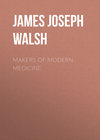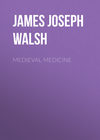Buch lesen: «The Popes and Science», Seite 5
THE STORY OF ANATOMY DOWN TO THE RENAISSANCE
We have seen that the supposed prohibition of anatomy by the Popes has no existence in reality. In spite of this fact, which it was easy for anyone to ascertain who wished to consult the documents asserted to forbid, a number of historical writers have insisted on finding religious or ecclesiastical, or theological, opposition to anatomical studies. Professor White has been most emphatic in his assertions in this regard. He admits that the supposed bull of prohibition had quite a different purport, yet he still continued to assert its connection with the failure of anatomy to develop during the Middle Ages. This presumed failure of anatomy during the Middle Ages is a myth. It continues to secure credence only in the minds of those who know nothing of the history of medical science during the thirteenth, fourteenth, and fifteenth centuries and who have not consulted the serious histories of medicine that treat of this time, but flourishes vigorously in the minds of those who have a definite purpose in making out a story of theological or Church opposition to science in general.
To counteract the false impression that has gained such wide acceptance in this matter, it has seemed advisable, in order to settle the question definitely once and for all, to trace the history of anatomical science from its beginning in the Middle Ages down to modern times. It will not be hard to show that there was a constant development and an unfailing interest in this subject. This can be understood even more clearly from the story of the development of surgery in the Middle Ages and its relations to anatomy than from the history of anatomy itself. As is well known, materials with regard to practical and applied science interest men more at all times, and documents with regard to them are more likely to be preserved, and so the history of surgery is very full, while the history of anatomy may prove not quite so satisfactory. It is true of all sciences, that there are periods when they have much less attraction than at other times, and the success of investigators and original workers is not always the same. As in nearly everything else, the real advances in all science come when genius makes its mark, and not merely because a large number of men happen to be interested in the subject. This will be found as true in anatomy as in other sciences, and so there are periods when not much is doing, but nowhere is there a trace of ecclesiastical opposition to account for these variations of interest.
There is no doubt at all that there was much popular opposition to the practice of dissection in the Middle Ages; that has existed at all times in the world's history. It was very pronounced among the old Pagans in Rome as well as in Greece, and it prevented anatomical study to a very great degree. It continued to exist in modern times until almost the present generation. Indeed, it has not yet entirely disappeared, as any physician who has tried to secure autopsies on interesting cases knows very well. The New York Academy of Medicine is only a little over a half century old, and yet nearly every one of its early presidents had thrilling experiences in body-snatching as a young man, because no proper provision for the supplying of anatomical material had as yet been made by law, and bodies had to be obtained. The feeling of objection to having the bodies of friends anatomized is natural and not due to religion. It exists quite as strongly among the ignorant who have no religion as among the religiously inclined. It has not disappeared among the educated classes of our own time, religious or irreligious. If this is borne in mind, the history of the development of anatomy will be easier to understand.
The first definite evidence in modern history for the existence of the practice of dissection is a famous law of the German Emperor, Frederick II., from the first half of the thirteenth century. This law was promulgated for the two Sicilies, that is, for Southern Italy and Sicily proper, very probably in the year 1240. It has often been vaguely referred to, but its actual significance can only be understood from the terms of the law itself, which has been literally translated by Von Töply in his Studien Zur Geschichte der Anatomie in Im Mittelalter. [Footnote 5]
[Footnote 5: Deuticke Leipzig und Wien, 1893]
The paragraph with regard to dissection runs as follows:
"As an enactment that will surely prove beneficial to health, we decree that no surgeon will be allowed to practice, in case he has not a written testimonial, which he must present to the teachers in the medical faculty, that he has for at least a year applied himself to that department of medicine which is concerned with the teaching and practice of surgery, and that he has, above all, learned the anatomy of the human body in this manner, and that he is fully competent in this department of medicine, without which neither surgery can be undertaken with success nor sufferers cured." [Footnote 6]
[Footnote 6: The complete text of this law, which is a marvelous anticipation of all our efforts for the regulation of the practice of medicine down even to the present day, will be found in the appendix.]
Such a regulation, as pointed out by Professor Pilcher in an article on the early history of dissection, [Footnote 7] and as we know by modern experience, does not come into force as a rule before the actual practice of what is prescribed, has been for some time the custom and its usefulness proved by the results attained. It seems very probable, then, that even at this early day the Emperor Frederick was only making into a law what had been at least a custom before this time. Lest anyone should think that this is a far-fetched assumption, certain other paragraphs of this law, which show very definitely the high degree to which the development of medical teaching had reached, must be recalled. Frederick declared that medicine could only be learned if there was a proper groundwork of logic. Only after three years devoted to logic, then, under which term is included the grammar and philosophy of an ordinary undergraduate course, could a man take up the study of medicine. After three years devoted to medicine, to which it is again specifically declared another year must be added if surgery were to be practiced, a man might be given his degree in medicine, but must spend a subsequent full year in the practical study of medicine under the supervision of an experienced physician.
[Footnote 7: The Mondino Myth, Medical Library and Historical Journal, 1906]
The law further decreed definite punishments for the practice of medicine without due warrant and violation of its regulations, and also regulated the practice of apothecaries. It is rather interesting to find that these were forbidden to share their profits with physicians, and the physicians themselves were not allowed to distribute their own medicines. In a word, practically every one of the problems in the practice of medicine which medical societies are trying to solve at the present moment, were also occupying the attention of the civil authorities about seven centuries ago. Anyone who reads this law will not be loath to believe that it represents the culmination of a series of efforts to regulate medical practice, and especially medical education, and that it was not merely a chance legal utterance that happened to touch a single important question for the first time. One of the paragraphs of the law even contains some clauses that would prevent fake medical schools and that establishes a board of medical examiners. This consisted of certain state officials and some professors of the art of medicine. In a word, medical education had reached a high grade of development, and medical practice was legally established on a high plane of professional dignity.
Salerno had already enjoyed a high reputation as a medical school for more than two centuries when Frederick's law was promulgated. It is true that we have no definite records of dissections done in the school. If these were not an uncommon occurrence, however, but came as did dissections later on, quite as a matter of course, the absence of such records, when we recall how liable to destruction were the meagre accounts of the university transactions of the time during the long period that has intervened and because of the many vicissitudes they were liable to, is not surprising. During the century following this decree there seems to be no doubt that dissections were done regularly, though perhaps not very frequently from our modern standpoint, at Salerno. Salerno, as we shall see in the chapter on The Papal Medical School, was always closely in touch with the ecclesiastical authorities, and especially with the Papacy. There was no hint of friction of any kind, either before or after this law of Frederick's. The question of ecclesiastical interference with dissection does not seem to have arisen at all, much less to have proved an obstacle to the development of medical science.
At the beginning of the fourteenth century the center of interest in anatomy and the matter of dissections shifts to Bologna. We have already discussed the question whether Mondino was the first to do public anatomies, and as to whether he performed only the few that by a narrow misunderstanding of certain of his own words have sometimes been ascribed to him. Professor Pilcher, in the article The Mondino Myth, already cited, is of the opinion, and gives excellent reasons for it, that Taddeo, the great Bolognese physician of the thirteenth century, who was Mondino's master, had done at least some dissections in Bologna. Personally I have long felt sure that Taddeo or Thaddeus, as he is sometimes called in the Latin form of his name, did not a few, but a number of dissections.
Professor Pilcher's account of him does not exaggerate his merits. I may say that he was one of the great Papal physicians of whom we shall have more to tell hereafter.
"Any comprehensive attempt to trace the real influences to which was due so great a step as a return to the practice of dissections of the human body, seems to me must be very defective if it failed to take into consideration the influence of such a man as Thaddeus (Italian Taddeo). That he was able to impress himself in the way in which history records that he did, both upon the general public and upon the scholastic foundations of Bologna, shows a strength of character and a mastery of the peculiar conditions of the moment in the fields of science and philosophy which made him a master and an inspirer. If he is to be considered in his proper historical light, as one who declares that the knowledge of the structure of the human body to a most minute degree is the foundation upon which all rational medicine and surgery must be built, then it is impossible to exaggerate the importance of the pivotal moment when, in the development of science, the human body began to be anatomized. Nor is any fault to be found with the custom which has crowned with the laurels of universal appreciation the names of those men who began and who continued anatomical study, who vulgarized the practice of dissection.
"In my own investigations and reflections upon the conditions which led up to this happy renewal of scientific search into the composition of the body of man, it has seemed to me that writers have hitherto fallen short of tracing through to its ultimate source, the earlier spirit of enthusiasm for knowledge, of insight into the problems of disease, and of contempt for traditionary shackles, to the influence of which, as shown by the master, Taddeo, the latter work of the pupil, Mondino, was in great measure due."
Medici, in his History of the School of Anatomy at Bologna, [Footnote 8] quotes Sarti on The Distinguished Professors of the University of Bologna for proof of Taddeo's familiarity with dissection. Von Töply does not think that this quotation is enough absolutely to prove that Taddeo had done dissections, yet it would be hard to understand it unless some such interpretation is made. Taddeo was asked to decide a medico-legal question with regard to a pregnant woman. He refused, however, with a modesty that might well be commended to medico-legal experts of more modern times, to answer the question decisively, because he had never made a dissection of a pregnant woman. Sarti argues that it is evident from this that he had dissected other bodies more easy to obtain than those of pregnant women, or else that he had had the opportunity to make observations on them when dissected by others.
[Footnote 8: Medici Compendio Storico Della Scuola Anatomica de Bologna, Bologna, 1857. ]
Certain of Taddeo's contemporaries must have had the incentive of his example to help them to a knowledge of human anatomy, for they surely could not have accomplished all that they did in surgery without experience in dissection, yet Taddeo was looked up to as a master by all of them.
Anyone who has read the contributions to surgery of William of Salicet and his great pupil Lanfranc, even if only what we give with regard to them in our chapter on Surgery during the Middle Ages, cannot but be impressed with the idea that they must have done human dissections. They do not mention this fact explicitly, but portions of their surgical works are taken up with the consideration of applied anatomy. They discuss the relations of various structures to one another, especially with reference to the surgery of them. Von Töply, in his Studies on the History of Anatomy in the Middle Ages, says that the anatomies written before William's chapters on applied anatomy, were most of them purely theoretic discussions meant to be guides for internal medicine, or else they were very short directions for those who undertook the practical work of the dismemberment of bodies, usually, however, with reference to animals rather than to human bodies. In William of Salicet we encounter, he says, for the first time a treatise on anatomy made with the deliberate purpose of its application to practical surgery. Everywhere William gives hints for surgical operations with special reference to the anatomical relations.
Puccinotti quotes from William of Salicet's surgery, written about 1270, a passage that shows how familiar this surgeon must have been with dissection. The nephew of Count Pallavicini received an arrow wound in the jugular vein and died within an hour. During his death agony he suffered from a peculiar form of rattle in his throat. It was thought that this might be due to the fact that the arrow had been poisoned. William was called in to decide this question, and found that there was nothing responsible for his death except the wound itself. He describes how he found the blood in the lungs and in the heart, and considers that the conditions that were present were due to the wound. Von Töply has suggested that William would have given more details had he actually examined these organs, but when the autopsy report is negative, such descriptive details are not usual even at the present time. If he had found reason for thinking that there was poison in the case, a careful description of the other organs would be necessary. The fact, however, that he was asked to decide such a question, would seem to indicate that he was supposed to have a knowledge of the normal appearances of human tissues when examined by dissection.
In everything else Lanfranc went farther than his master William, and he did so also in anatomy. Some of the details of his work will be found in our chapter on Surgery in the Middle Ages. He could not have been able to give the detailed instructions that he has for the treatment of every portion of the body only that he knew them by actual contact in the cadaver as well as the patient. His outlook upon scientific medicine and surgery would satisfy even the most exacting of modern experimental scientists. The famous aphorism of his runs as follows: "Every science which depends on operation is greatly strengthened by experience." More than anything else, however, surgery owes to Lanfranc the distinct advantage that he carried into the West as far as Paris, the methods which had come into existence in Italy, and were ever after to prove a precious heritage in the great French University. As Salicet's work was carried on by Lanfranc, at least as well was Lanfranc's work further advanced by his pupil and successor in the chair of surgery, Henri de Mondeville. This subject of surgical development will be treated in the chapter on Surgery in the Middle Ages. Here it is introduced only to emphasize the opportunity there must have been for anatomical study through dissection in the thirteenth century, or these men would not have made the marvelous progress they actually accomplished in this department.
With regard to Mondino, Taddeo's successor at Bologna, enough has been said already in the preceding chapter. About this time, however, very definite evidence begins to accumulate of the frequent practice of dissection. Roth, whose life of Vesalius is a standard work in the history of anatomy, has summed up most of what we know with regard to dissections in the early part of the fourteenth century, in his chapter on Dissection Before Vesalius's Time. Roth's work is well known and is frequently referred to in Dr. White's History of the Warfare of Science with Theology. There can be no question, then, but that in taking what Roth has to say I shall be quoting from a work with regard to which there can be no hint even of partiality. Roth himself was a Swiss, with no leaning toward the Church. There are certain portions of his book, indeed, in which he is inclined not to allow that the Church did as much for education in these times as she actually did. His study of the rise of anatomy can be accepted with absolute assurance, that it is at least not written from the standpoint of one who wants to make the situation with regard to anatomy more favorable than it actually was during the fourteenth century, for the sake of showing any lack of opposition on the part of ecclesiastics.
Some of the material that Roth has made use of has already been referred to in the preceding chapter, but it has seemed proper to repeat it here because this gives a connected account from a definite authority in the history of medicine, and especially of anatomy, with regard to the century immediately following the promulgation of Boniface's bull. Besides, it gives an opportunity for such comments on various features of the history of anatomy, as he details it, as will bring out the significance of his remarks. His account will make it very clear that, far from the Papal bull in question having been universally construed as prohibiting dissections, as Dr. White says it was, it never entered into the minds of medieval anatomists to consider it as having any such signification. The bull was never thought of in that sense at all. It does not refer to anatomy or dissection and it never had any place in the history of anatomy until dragged into it without warrant by Daunou and other nineteenth century writers. Roth says:
"In the pre-Vesalian period the dissection of the human body was practiced, according to the terms of Frederick's law, for the instruction of those about to become physicians and surgeons. The natural place for this school anatomy–for a dissection was called anatomia, or, erroneously, anatomia publica–was at the universities and the medical schools. Apart from teaching institutions, however, public anatomies were held in Strasburg and in Venice. Their purpose was the instruction of the practicing medical personnel of these towns. Dissections which were not made for general instruction were called private anatomies. They were performed for the benefit of a few physicians, or students, or magistrates, or artists. Private anatomies began to have special importance only toward the end of the pre-Vesalian period (this would be about the end of the fifteenth and the first quarter of the sixteenth century). It is a play of chance that the first historical reference to a dissection concerns a private anatomy, one undertaken for the purpose of making a legal autopsy. This was made in Bologna in the year 1302 (two years after the decretal supposed to forbid dissection). A certain Azzelino died with unexpected suddenness, after his physicians had visited him once. A magistrate suspected poison and commissioned two physicians and three surgeons to determine the cause of death. It was found that death resulted from natural causes. (As I have said, it would appear that this was not an unusual procedure, for unless medical autopsies had been done before, it does not seem probable that this method of determining the cause of death would have been so readily taken up.)
"Thirteen years later there is an account of the dissection of two female bodies, in January and March of the year 1315, performed by Mundinus." (We have already seen that the fact that the two female bodies should be especially mentioned, though taken by some historians of medicine to indicate that Mundinus had done but few dissections, will not stand such an interpretation, in the light of the evidence that he had dissected many male bodies at least, as his text-book of anatomy indeed makes very clear. These two dissections of females happened only to have special features that made them noteworthy.) "A few years later (1319) there is a remarkable document which tells the story of body-snatching for dissecting purposes." (This would seem to be sufficient of itself to show that a number of dissections were being done, and, indeed, as I have already said, Rashdall, in his History of the Universities, states that, according to the University statutes teachers were bound to dissect such bodies as students brought to them.) Roth concludes with the words (italics are mine): "These are a few, but weighty testimonies for the zeal with which Bologna pursued anatomy in the fourteenth century." (I may add that all of these concern the twenty years immediately following Pope Boniface's supposed prohibition.)
Nor was the custom of making dissections any less active during the rest of the half century after the time when, if we are to believe Professor White, the decree of Boniface had been universally interpreted to forbid it. In a note to his history of dissection during this period in Bologna, Roth says: "Without doubt the passage in Guy de Chauliac which tells of having very often (multitoties, many times, is the exact word) seen dissections must be considered as referring to Bologna." This passage runs as follows: "My master, Bertruccius, conducted the dissection very often after the following manner: The dead body having been placed upon a bench, he used to make four lessons on it. First, the nutritional portions were treated, because they are so likely to become putrified. In the second, he demonstrated the spiritual members; in the third, the animate members; in the fourth, the extremities." (Guy de Chauliac was at Bologna studying under Bertruccius just before the middle of the fourteenth century. It is evident beyond all doubt, from what he says, that dissections were quite common. This is during the first fifty years after the decree. I shall show a little later that there are records of dissections during the second half of this century. Roth, however, goes on to tell next of the fifteenth century.)
Roth says nothing about the decree of Boniface VIII., nor of any possible effect that it had upon anatomy. The real historian, of course, does not mention things that have not happened. Roth confesses, as I have said, that he takes the material for his sketch of anatomy before Vesalius's time from Corradi. [Footnote 9] Corradi being an Italian, and knowing of the slander with regard to the Papal decree, explicitly denies it. Surely, here is material enough to convince anyone that all that Professor White has said with regard to the supposed effect of the misinterpretation of Boniface's decree is without foundation in the history of anatomy. Within twenty years after the bull was issued dissection was practiced to such an extent, that body-snatching became so common that there were prosecutions for it, and public dissections seem to have been held every year in the universities of Italy during most of the fourteenth century.
[Footnote 9: Corradi Dello Studio e dell' Insegnamento dell' Anatomia in Italia nel Medio Evo ed in parte del Cinquecento, Padova, 1873.]
De Renzi [Footnote 10] gives an interesting account of the methods by which material was obtained for dissection purposes before governments made any special provision for this purpose. Naturally, the rifling of graves was resorted to by students intensely interested in the subject of anatomy. The first criminal prosecution for body-snatching on record is in 1319, when some students brought a body to one Master Albert, a lecturer in medicine at the University at Bologna, and he dissected it for them. At this time, according to the statutes of the university, teachers of anatomy were bound to make a dissection if the students supplied the body. The whole party were brought to trial for this offence, though they do not seem to have suffered any severe penalty for their violation of the laws. At this time, according to De Renzi, there was a rage for dissection and many bodies were yearly obtained surreptitiously for the purpose.
[Footnote 10: De Renzi Storia della Medicina in Italia, Napoli. 1845-49, Vol. II., p. 247.]
With regard to the bodies of condemned criminals, people began to countenance the procedure, and while unwilling as yet to give them freely, allowed the bodies to be taken. Corradi, quoted by Puschmann, says "that laws against the desecration of graves, without being abolished, became a dead letter. The authorities interfered only if decided violence had been used or a great scandal raised. Such consequences were likely to follow only if, in the ardor of their enthusiasm for anatomical knowledge, students rifled the graves of well-known persons or took the bodies of those whose relatives discovered the desecration and proceeded against the marauders by legal measures."
At the Italian universities after the middle of the fourteenth century there is abundant evidence for perfect freedom with regard to dissection. We have already shown by our quotation from Roth that Bertrucci was very active in dissection work and did many public dissections. He was followed by Pietro di Argelata, who died toward the end of the fourteenth century. These men followed Mondino in the chair of anatomy at Bologna, and Julius Pagel, in his chapter on Anatomy and Physiology in Puschmann's Handbuch der Geschichte der Medizin (Vol. I., p. 707), says that "the successors of Mondino were in a position, owing to the gradual enlightenment of the spirit of the time and the general realization of the importance of anatomy as well as the fostering liberality of the authorities, to make regular, systematic dissections of the human body." This would bring us down, then, to the end of the fourteenth century.
To return now to Roth, who takes up the next century. He says:
"For the fifteenth century, the university statutes of Bologna for the year 1405 furnish many sources of information. There is a special division which is concerned with the annual anatomy or dissection that had to be made and the selection of the persons to be present, the payment of the expenses and other details. An addition to the statutes, made in the year 1442, determines the arrangement of the delivery of the body from the city to the university authorities. Every year two bodies, one male and one female, must be provided for the medical school dissections. In default of a female body, a second male body was to be provided. In the presence of such detailed regulations, the absence almost entirely of details as to the actual performance of dissections can mean very little. Bologna reached its highest development as a medical school at the beginning of the sixteenth century when Alexander Achillinus and Jacob Berengarius had charge of the public dissections there. Of these I shall speak later." (All this is at the University of Bologna, where ecclesiastical influence was supreme and where the Popes exercised their jurisdiction as the ultimate authority to be appealed to in all disputed educational questions.)
Roth continues: "Padua had, like Bologna, dissection in the fourteenth century. There is the record of a dissection made in the year 1341, in which Gentilis made the discovery of a gall-stone." (It is evidently not because the dissection was unusual, but because the discovery was unusual, that this incident is mentioned. The dissections were such ordinary occurrences as not to deserve special mention except for some particular reason.)
"Much more is known about dissection at Padua in the fifteenth century, when the city had become Venetian." [Footnote 11] (It is significant to note that the previous occurrence was in pre-Venetian days, for Professor White insists that it was the Venetian authorities, in opposition to the Pope, who allowed dissection at Padua. Here is the rebuttal of any such theory.) "Bertapaglia, in his Surgery, has the record of the dissection of a criminal made under the direction of Master Hugo De Senis, on the 8th of February, 1429. On the 4th of April, 1430, the dissection of a woman was made. In 1444 Professor Montagnana speaks of fourteen dissections at which he had been present." (This would seem to indicate that dissections were quite common and that the occasional records of them give no proper idea of their actual number.)
[Footnote 11: Note that this is a full century before Vesalius's time, who, Professor White insists, reintroduced dissection.]
I would not wish to produce the impression, however, that Italy was the only place in Europe in which dissections were freely done during the fourteenth and fifteenth centuries. There is no doubt that anatomy and surgery and every branch of medicine was cultivated much more assiduously and with much better opportunities provided for students down in Italy, than anywhere else in the world. This of itself alone shows the utter absurdity of the declarations that the Church was opposed to medical progress in any way, since the nearer the center of Christendom, the more ardor there was for investigation and the more liberty to pursue original researches. Other countries also began to wake up to the spirit of progress in medical education that was abroad. In France there were two centers of interest in anatomy. One of these was at Montpelier, the other at Paris. It is interesting to note, however, that the men to whom anatomical progress is due at these universities obtained their training, or at least had taken advantage of the special opportunities provided for anatomical investigation to be had, in the Italian cities. Guy de Chauliac I have already mentioned. He is spoken of as the Father of Modern Surgery, and there is no doubt that he did much to set surgery on a very practical basis and to make anatomy a fundamental feature of the training for it. He declared that it was absurd to think that surgeons could do good work unless they knew their anatomy.


















